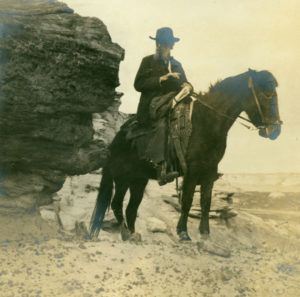Tag: fromthearchives
From the Archives: Sauntering in the Sierra
Sauntering in the Sierra
by Roger Eardley-Pryor, PhD
@Roger_E_P

Deep into Sequoia National Park, a thin, wiry rider climbed a mountain trail atop a dusty white horse. He wore a dark business suit, per his backcountry custom, and from under his black felt hat, a bushy white beard spilled forth. Up the Kern River Canyon, a group of young Sierra Club members trekked through the high country. As the rider approached them, his piercing blue eyes surveyed the group from under his shadowy hat.
“Where are you going?” the rider inquired.
“We’re just hiking in to camp,” the hikers replied.
“Hiking is a vile word,” the rider returned. “You are going right past one the finest views in the Sierra. Now stop and look at it.”
It was the summer of 1908, and the young Sierra Club members heeded his command. For they knew the thin, dark rider was John Muir, famed mountaineer and co-founder of the Sierra Club.
“You know,” Muir said, “when the pilgrims were going from England to the Holy Land, the French would ask them ‘Where are you going?’ They did not speak French very well, but they would say ‘Santa Terre’ (Holy Land). That is where we get our word ‘saunter.’ And you should saunter through the Sierra, because this is a holy land, if ever there was one.”
When John Muir preached this parable of wilderness-appreciation in 1908, he left an indelible mark in the mind of C. Nelson Hackett, who recalled the encounter in a 1972 oral history interview. Hackett was born in the City of Napa in 1888. He joined the Sierra Club during high school and later earned degrees from the University of California, Berkeley and Harvard Law School. After a stint in the U.S. Army, Hackett worked at the Bank of California (now MUFG Union Bank) where he became vice president and headed its trust department. When interviewed at eighty-three years old, Hackett recalled, “I don’t know of anything in my life that has been more delightful than those Sierra Club outings.” In 1908, during Hackett’s outing, Sierra Club membership had just reached 1000. Today, with three million members and supporters, Sierra Club is the largest and most influential grassroots environmental organization in the United States.
Hackett’s memory of Muir comes from Sierra Club Reminiscences II, 1900s-1960s, part of the Oral History Center’s extensive collection of interviews with Sierra Club leaders and longtime members. The roots of the Oral History Center’s relationship with the Sierra Club stems, in part, from a chance encounter on a long bus trip from San Francisco north to the dedication of the newly established Redwood National Park in August 1969. On that bus trip, Phillip Berry, then recently elected as the Sierra Club’s youngest president, sat next to Amelia Fry, an oral historian from the Bancroft Library. Fry had interviewed former National Park Service directors Horrace M. Albright and Newton Drury, and many others associated with natural resources and politics. While riding to Redwood National Park, Fry convinced Berry about the value of preserving the Sierra Club’s unwritten stories through oral history interviews. In May 1970, the club’s board of directors authorized the Sierra Club History Committee, which partnered with the Oral History Center to begin recording reminiscences of longtime club members in 1971. This interview series continued until the mid-2000s, during which the Oral History Center collected nearly one hundred Sierra Club interviews with former presidents and directors, including Ansel Adams, Edgar Wayburn (two interviews), David Brower (two interviews), Michael McCloskey (two interviews), and Carl Pope. Funding challenges brought a halt to the project, but the Sierra Club oral histories remain available online and preserved at The Bancroft Library. Today, the Oral History Center is planning to revive the series in conjunction with the club’s William E. Colby Memorial Library.
If you want to donate to this important project , please contact oral history interviewer Roger Eardley-Pryor at rogerep@berkeley.edu.